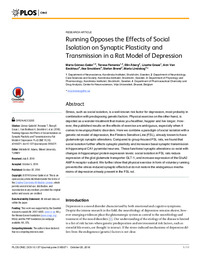Title:
Running opposes the effects of social isolation on synaptic plasticity and transmission in a rat model of depression |
Authors:
Gómez Galán, Marta
Femenía Cantó, Teresa
Aberg, Elin
Grage, Lisette
Van Eeckhaut, Ann
Smolders, Ilse
Brené, Stefan
Lindskog, Maria |
Editor:
Public Library of Science |
Department:
Departamentos de la UMH::Farmacología, Pediatría y Química Orgánica |
URI:
https://hdl.handle.net/11000/35430 |
Abstract:
Stress, such as social isolation, is a well-known risk factor for depression, most probably in
combination with predisposing genetic factors. Physical exercise on the other hand, is
depicted as a wonder-treatment that makes you healthier, happier and live longer. However,
the published results on the effects of exercise are ambiguous, especially when it
comes to neuropsychiatric disorders. Here we combine a paradigm of social isolation with a
genetic rat model of depression, the Flinders Sensitive Line (FSL), already known to have
glutamatergic synaptic alterations. Compared to group-housed FSL rats, we found that
social isolation further affects synaptic plasticity and increases basal synaptic transmission
in hippocampal CA1 pyramidal neurons. These functional synaptic alterations co-exist with
changes in hippocampal protein expression levels: social isolation in FSL rats reduce
expression of the glial glutamate transporter GLT-1, and increase expression of the GluA2
AMPA-receptor subunit. We further show that physical exercise in form of voluntary running
prevents the stress-induced synaptic effects but do not restore the endogenous mechanisms
of depression already present in the FSL rat.
|
Knowledge area:
CDU: Ciencias aplicadas: Medicina: Farmacología. Terapéutica. Toxicología. Radiología |
Type of document:
info:eu-repo/semantics/article |
Access rights:
info:eu-repo/semantics/openAccess
Attribution-NonCommercial-NoDerivatives 4.0 Internacional |
DOI:
10.1371/journal.pone.0165071 |
Published in:
PLoS ONEO, 2016;11(10): e0165071 |
Appears in Collections:
Artículos - Farmacología, Pediatría y Química Orgánica
|

.png)
